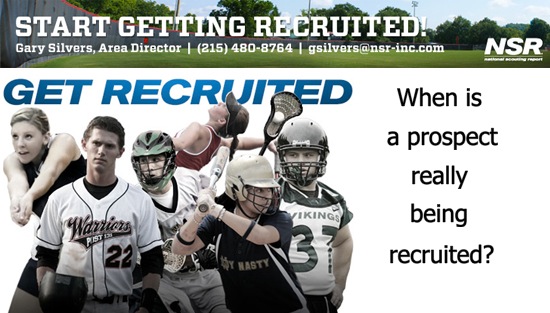- Log in to post comments
The following article is sponsored by National Scouting Report. Visit NSR’s web site at http://www.nsr-inc.com/

When is a prospect really being recruited?
High school athletes and their families often suffer the indignity of being unceremoniously dropped from consideration by college coaches. It can happen anytime to anyone. Nobody is safe from the recruiting guillotine.
Why is college recruiting so cutthroat?
First of all, recruiting is all about numbers -- the more, the merrier – for college coaches. The Internet has dramatically changed recruiting and the number of athletes coaches can access, evaluate and contact. Each week, coaches receive huge numbers of profiles on prospects, so many that they typically never see a large percentage of them.
So, even though a college coach may have initially distributed 1,000 letters with questionnaires to prospects, it would be virtually impossible to give every return equal attention.
Altered NCAA rules over the last five years (the NAIA has always been less strict) have made connecting with prospects easier than ever. Whether by phone, email, social media or text, coaches have a choice of ways to reach recruits. Because all of these are now on mobile platforms, coaches and prospects are linked in an instant anytime, any place.
However, coaches only have so much time. Responding to every inquiry is an unreasonable expectation. So, early on, coaches pinpoint the prospects with whom they will communicate, leaving a large number of aspiring prospects sitting in the dark waiting for return emails, calls or texts which are unlikely to come.
Recruiting is not a lottery or a draft. It works like a funnel. A lot of prospects go into the top but only a few emerge from the bottom. That means a large number of prospects are knowingly or unknowingly discarded, much to the chagrin of prospects and their families. Again, that has become the nature of the beast.
When recruiting is in full swing between coaches and prospects, the process becomes all about two things: academic qualifications and interpersonal relationships. So if there are personality incompatibilities; a better prospect emerges; a parent overreaches his or her perceived influence; a GPA drops; or a standardized test score turns up too low, a prospect can be eliminated.
College coaches initially connect with as many potential prospects as possible, usually through recruiting letters, emails and questionnaires. That is only the first step and, other than the fact that a coaching staff has a prospect's profile and video in hand, does not mean much more.
The next step is when coaches target and follow certain prospects -- based on the data they have received -- who could fit their criteria. That includes skills, grades and other essentials on the coaches’ priority lists. That is when a large number of prospects are dropped.
There are several reasons a coach may eliminate prospects from consideration. The most common is when a prospect believes he or she is being recruited when they actually are not. A letter from the school's program; a complimentary word to a high school, club or travel coach; or showing up at a prospect's game are often misinterpreted by prospects and their parents. These do not mean a prospect is being recruited, and knowing that can save a prospect and family a great deal of unnecessary pain.
The NCAA defines precisely when a prospect is formally designated as a recruited student-athlete. That is when an NCAA coach:
- Provides the prospective student-athlete with an official visit;
- Has an arranged, in-person, off-campus encounter with the prospective student-athlete or the prospective student-athlete's parents, relatives or legal guardians;
- Initiates or arranges a telephone contact with the prospective student-athlete, the prospective student-athlete's relatives or legal guardians on more than one occasion for the purpose of recruitment; or
- Issues a National Letter of Intent or the institution's written offer of athletically related financial aid to the prospective student-athlete. However, issuing a written offer of athletically related financial aid to a prospective student-athlete to attend a summer session prior to full-time enrollment does not cause the prospective student-athlete to become recruited.
College recruiting doesn't become serious until one of those four occurs. Until then, every recruit must understand and accept that he or she is in recruiting limbo.
Want to be seriously recruited? National Scouting Report, the world’s oldest and largest college recruiting organization, has received hundreds of requests from college coaches seeking qualified high school prospects (2016-19) in all sports. More than 95 percent of NSR’s prospects receive scholarship offers. For a FREE evaluation and in-home consultation, contact NSR Area Director Gary Silvers, former Executive Sports Editor of the Bucks County Courier Times, at (215) 480-8764 or gsilvers@nsr-inc.com.

